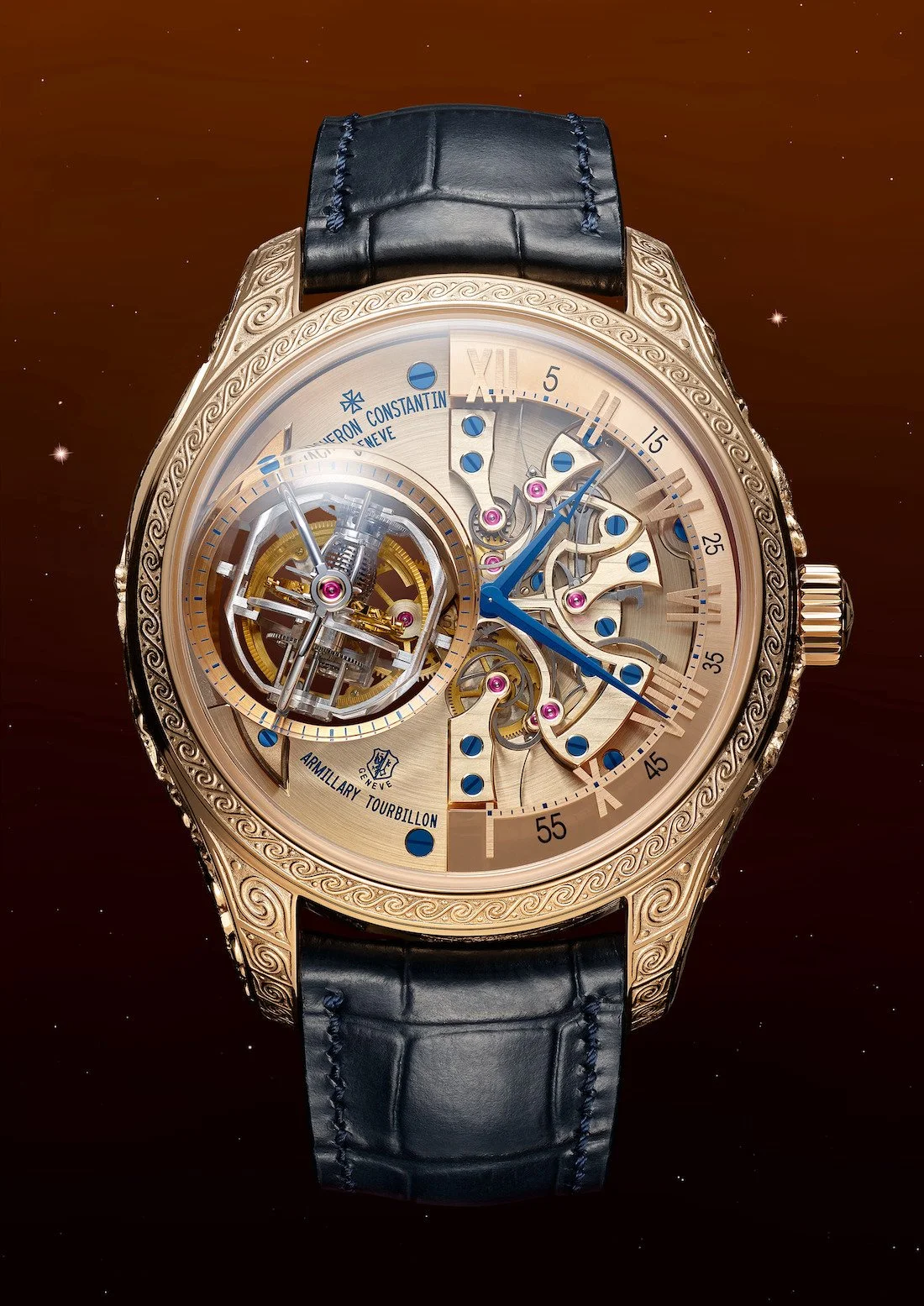Vacheron Constantin marks its momentous 270th anniversary with another horological masterpiece that transcends conventional watchmaking boundaries. The new Les Cabinotiers Armillary Tourbillon ‘Myth of the Pleiades’ represents the latest addition to the 'La Quête' series—a tribute to astronomy and the odysseys of ancient times—and stands as a testament to the Maison's unwavering commitment to blending grand complications with exceptional artistic crafts.
As the world's oldest continuously operating watch manufacture, Vacheron Constantin has spent nearly three centuries perfecting the art of creating one-of-a-kind timepieces that push technical and aesthetic boundaries. This unique-piece edition in 18K rose gold, featuring a fully engraved case with diamond-set sides sculpted in bas-relief, doesn't just tell time—it tells the story of humanity's eternal quest to understand and navigate by the stars.
The Mythological Foundation
The watch draws its inspiration from one of Greek mythology's most captivating tales: the seven Pleiades, daughters of the Titan Atlas and the Oceanid nymph Pleione. Pursued relentlessly by the hunter Orion for seven years, these sisters were saved by Zeus, who transformed them into a constellation in the celestial vault. Yet even in the heavens, they found no peace. Orion followed them into the starry sky, prompting Zeus to intervene once more by placing Taurus, the celestial bull, as a protective barrier between the hunter and his prey.
Beyond mythology, the Pleiades served as vital navigational reference points for ancient mariners, marked on the Nebra sky disc as early as 1600 BC and mentioned in Homer's Iliad and Odyssey eight centuries later. This dual significance—both mythological and practical—makes them the perfect subject for a watch that celebrates humanity's inexorable desire to master space and time.
The Case: 450 Hours of Engraving Excellence
The artistic dimension of this watch rivals its technical achievements. Master engravers at Vacheron Constantin drew inspiration from Polish astronomer Johannes Hevelius (1611–1687), who mapped the Moon, discovered comets, compiled comprehensive star catalogs, and produced one of the first accurate star atlases, linking constellations to mythological figures.
The case, crafted in 18K 4N pink gold, measures 45 mm in diameter and 20.13 mm in thickness. On the crown side, a cloudy sky reveals Orion emerging with sword and shield, ready for battle to conquer the Pleiades—the stars protected by the celestial bull sent by Zeus. The opposite side of the case depicts the ship Argos, described by Ptolemy (circa 100–168) as an ancient constellation, bearing an image of the protective goddess Athena on its sail. In search of the Golden Fleece, Argos navigates waves populated by sea monsters, chimeras, and dolphins, using the Pleiades of the constellation Taurus—represented in Hevelius's style—as a navigational beacon.
Creating these compositions on the 20 mm high case required extraordinary skill. The engraver first drew outlines using drypoint—a painstaking task given the profusion of detail—then brought out volumes with a burin, carefully removing material while ensuring incisions didn't exceed 1 millimeter depth. Micro-sculpting work followed, giving the final form to Hunter Orion, Bull Taurus, and clouds on one side, with sea creatures, the ship, waves, and the bull's head on the other.
Working in collaboration with the gem setter, the engraver determined the locations for 10 brilliant-cut diamonds representing the Pleiades. While mythology names the Pleiades as seven sisters, astronomers know them as an open cluster of approximately 3,000 stars in Taurus, with 10 visible to the naked eye. The diamonds—in two sizes (0.6 and 0.9 mm)—are bezel-set at precise heights: six dot the sky on the crown side, while four are set within the Taurus sculpture on the opposite side.
Once gem-setting was complete, the engraver finalized the surfaces using the drypoint technique, alternating between polished and chased finishes to accentuate the contrasts. The ornamentation extends to the space between Taurus's horns, where three constellations surrounding the Pleiades (Aries and Musca at 12 o'clock, Gemini at 6 o'clock) appear in taille-douce engraving with chased finishes.
The bezel, lugs, and caseback feature wave-shaped champlevé engraving in Hellenic style. The engraver traced contours in drypoint, then incised patterns to depths between 0.1 and 0.2 millimeters—particularly challenging on extremely thin areas of the case back. Accentuating the pattern through chiseling hollows and polishing ridges presented another challenge given the fine lines. In total, this masterwork required 450 hours of engraving.
Calibre 1990: Four Patents of Pure Innovation
At the heart of this extraordinary timepiece beats Calibre 1990, a 299-part manual-wound manufacture movement born from the technical advances of the legendary Reference 57260—Vacheron Constantin's most complicated watch ever created. Protected by four patents, this movement represents a masterclass in contemporary haute horlogerie.
The bi-retrograde display of hours and minutes features the instantaneous return of both hands to zero at midday and midnight—a mechanism subjected to enormous forces that required meticulous attention to material selection and design. Titanium was chosen for the hands, offering superior lightness and strength compared to traditional steel. The retrograde time display appears on a semi-circular track marked with Roman numerals for hours and Arabic numerals for minutes. At the same time, the open dial construction reveals glimpses of the movement's mechanical complexity.
The four patents tell the story of innovation: the instantaneous retrograde system controlled solely by the minute cam, synchronizing both hands' jump at midnight or midday; the titanium escape wheel collet ensuring optimal isochronism; the architecture of the tourbillon cages forming a Maltese cross pattern every 15 seconds; and the titanium lever with diamond-coated pallets for increased wear resistance and optimized friction coefficient. While beating at a frequency of 18,000 vph, the movement provides a power reserve of 60 hours.
The Armillary Tourbillon: A Mechanical Ballet
The left side of the dial belongs entirely to the armillary tourbillon—a spectacular bi-axial complication displayed under a sapphire crystal dome at 9 o'clock. The name pays homage to 18th-century French watchmaker Antide Janvier, whose ingenious mechanism of moving spheres explained the apparent movements of celestial bodies.
This isn't just any tourbillon. Two aluminum cages nest inside each other, rotating on different axes at a rate of one rotation per minute, forming a sphere in perpetual motion. The tourbillon serves as a small-seconds display, equipped with a spherical balance spring invented by Jacques-Frédéric Houriet in 1814—an extraordinarily rare feature in contemporary watchmaking, requiring micron-level precision possessed by very few craftsmen.
To transmit impulses at 18,000 vibrations per hour (2.5 Hz), Vacheron Constantin developed an escapement with a titanium anchor and diamond pallets, reducing friction without requiring lubrication. The use of these high-tech materials contributes to chronometric performance that meets the requirements of the Swiss Official Chronometer Testing Institute (COSC)—particularly impressive given the substantial torque required by the instantaneous bi-retrograde mechanism throughout the 60-hour power reserve.
The technical sophistication extends to finishing details visible from both sides. The front features beveled and polished components, including a nickel-silver main plate with a circular satin finish, and blued screws that create contrast against the kinetic composition. The case back displays hand-beveled bridges decorated with horizontal Côtes de Genève and additional blued screws.
A Celebration of the Quest
The Les Cabinotiers Armillary Tourbillon – Myth of the Pleiades represents Vacheron Constantin at its most artistically and technically ambitious. This single-piece creation doesn't simply celebrate the Maison's 270-year history—it embodies the eternal human quest to understand our place in the cosmos, to navigate by the stars, and to create objects of lasting beauty that transcend mere timekeeping.
For the collector who appreciates the rarest expressions of haute horlogerie, this watch represents the absolute pinnacle where ancient mythology, astronomical precision, artistic mastery, and mechanical innovation converge. It's a reminder that the greatest watches aren't just instruments for measuring time—they're artifacts that connect us to humanity's most profound aspirations and enduring stories.
Sticker Price Upon Request. More info on Vacheron Constantin click here.
























